Sleeping Beauty of Cappadocia Population: 1,300
Old name: Sinasos
Mustafapaşa used to be a mysterious place that had somehow managed to miss the real Cappadocian tourism boom despite being no more than five km south of busy Ürgüp. However, in the 2010s it was well and truly discovered and now hotels are popping up all over it. Until 1924 and the population exchange this was the Sinasos of the Greeks, a name which lingers on with surprising tenacity, testimony perhaps to how much more important a place this used to be.
Mustafapaşa (the town of Mustafa Paşa, AKA Atatürk) is a town full of huge mansions with elaborately carved door and window-frames. Most date back to the 1880s, to a time when many local families had relatives working in the salt-fish trade in İstanbul (then Constantinople) and sending their money back to enrich their birthplace. There has not been such an intense period of building work between then and now when people are waking up to the potential of the old houses and rushing to restore them. Just as locals whinge about the noise and disruption of building work and sneer disparagingly at the overly grand tastes of the ‘nouveau riche’ now, so it’s possible to sit in the village square and imagine those same complaints echoing right the way back to the 19th century.
Around town
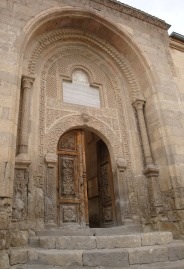 Coming into town from Ürgüp you will see, on the lefthand side of the road, the highly decorative entrance to the medrese opposite the architecturally uninspiring main mosque. This was built in 1900 at a time when Sinasos had two Greek Orthodox schools but none serving the minority Turkish Muslim population. Sadly, the new school had only been receiving pupils for 14 years when war broke out and it was requisitioned as an ammunition store. Now it is part of a vocational high school which has also swallowed up a nearby building with magnificent ceilings which once served as the Hotel Sinasos.
Coming into town from Ürgüp you will see, on the lefthand side of the road, the highly decorative entrance to the medrese opposite the architecturally uninspiring main mosque. This was built in 1900 at a time when Sinasos had two Greek Orthodox schools but none serving the minority Turkish Muslim population. Sadly, the new school had only been receiving pupils for 14 years when war broke out and it was requisitioned as an ammunition store. Now it is part of a vocational high school which has also swallowed up a nearby building with magnificent ceilings which once served as the Hotel Sinasos.
Of course, like everywhere in Cappadocia, this is a place to come in search of rock-cut churches and chapels. As you come into town from Ürgüp (before you reach the medrese) a sign on the right points the way to the Church of St Basil which was completely recut and repainted in the 19th century. Although the frescoes in the body of the church have been damaged those adorning the stairwell leading down to it survive miraculously intact. They include a representation of the Baptism of Christ as well as a painting of a king in all his finery. 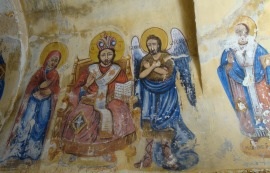
However, the most conspicuous church is actually a solid stone structure which stands right beside the main square. The Church of Sts Helena and Constantine was built in the 17th century, during the reign of Sultan Ahmed I (of Blue Mosque fame), but completely rebuilt in 1729 and then again in 1850.
A massive building with a triple-arched portico and an elaborate stone grapevine running round the entrance, it’s intermittently open to the public although there’s not much to see in the ruinous interior.
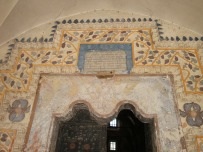 Signs around town point to the Bebek Muzesi (Doll Museum) which houses a collection of meticulously created models of different characters from Turkish life. Even without them it’s still worth dropping in to inspect what is a particularly fine old mansion with another stone grapevine carved onto a bedroom wall.
Signs around town point to the Bebek Muzesi (Doll Museum) which houses a collection of meticulously created models of different characters from Turkish life. Even without them it’s still worth dropping in to inspect what is a particularly fine old mansion with another stone grapevine carved onto a bedroom wall.
Near the village centre stands a building that achieved far more than its 15 minutes of fame in the early 2000s. The Old Greek House served as the original setting for the smash-hit television serial Asmalı Konak which resulted in a mini tourism boom to Mustafapaşa before Ürgüp stepped in to snap up the honour. These days the building has slumped back into its erstwhile torpor, although many locals swear by it as one of the best places to eat simple traditional home cooking in the region. What’s more diners (and hotel guests) get the chance to eyeball what is surely one of Cappadocia’s least likely frescoes – a painting above the stairs showing a man and woman on a swing that sums up how very different a culture it was that once ruled the roost here.
Next door to the Old Greek House there’s a magnificent gateway with what look like lion cubs carved on either side of it. This was built for Serapheim Rizos (1799-1889), a local benefactor, who had inscribed over it the words: ‘Man! If you are a friend, leave in happiness. If you are an enemy who threatens, keep away from this gate.’ His son Nicholas Rizos went on to become a scholar and the author of one of the first books about Cappadocia.
The valleys
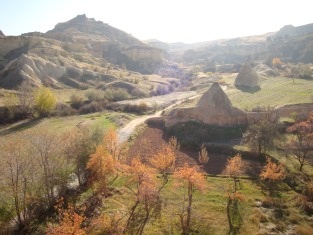 Mustafapaşa’s other rock-cut churches can be found in a valley that is clearly signed behind the arches across the road beyond the main square. The path has been paved and as it’s mainly level this is a good place for those with restricted mobility to visit.
Mustafapaşa’s other rock-cut churches can be found in a valley that is clearly signed behind the arches across the road beyond the main square. The path has been paved and as it’s mainly level this is a good place for those with restricted mobility to visit.
Even without the churches this would be a walk well worth taking. The scenery is glorious, with stubby fairy chimneys and rock formations that look like castles soaring up on either side. Unlike many trails through the Cappadocian valleys this path is also fairly flat. The hammering and twittering of woodpeckers, skylarks and great tits aside, the silence is absolute.
The tiny Church of St Stephen is on the right as you start along the path. Inside what is clearly a much older structure a crudely painted ceiling rose suggests that it was refurbished in 1907 when, perhaps, the poignant stone eagle supporting the lectern as in any British parish church was added.
At an unsigned fork in the road you must turn right to find the Monastery of St Nicholas. An impressive stone gateway stands as a reminder of the post-1856 period when a law prohibiting repairs to churches was repealed and most of the local ones were given a facelift. The monastery was completely restored in 2012, its original portico reinstated to the condition shown in photographs taken at the turn of the 20th century. Uniquely for Cappadocia, the outer wall of the rock-cut sanctuary is once again adorned with icons brought here from Greece.
In the courtyard crudely carved gravestones have been cleaned and relaid. Above the church a ladder leads into an old pigeon house. The view from the top of the rock is a delight. 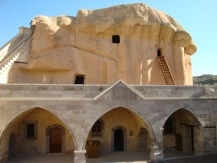 Monastery of St Nicholas
Monastery of St Nicholas
The path winds on until rock-cut steps on the left lead up to the Sinasos church. This, too, was obviously redecorated in the late 19th century when, perhaps, the sturdy stone pulpit was installed.
Shortly afterwards you’ll pass a huge fairy chimney with four neat niches cut into its base. A quick peek reveals what look like drains, making it fairly safe to assume that they once served as early monastic toilet cubicles.
Mustafapasa has one last treasure up its sleeve which is the extraordinary and appropriately-named Saklı Vadisi (Secret Valley). Here, inside a deep canyon of rock, tables are permanently set up ready for tea. Where is it exactly? Well, it wouldn’t be a secret valley if I told you, would it? It used to provide a popular venue for the annual Kapadokya Keyifler classical music concerts but after the death of its owner and the relocation of the concerts to Şirince it is no longer officially open to the public.
Sleeping
Lamia. Tel: 0384-353 5413 (summer only)
Bebek Konukevi. Tel: 0384-353 5221
Transport info
There are half-hourly buses throughout the main part of the day to and from Ürgüp whence there are connections to the rest of Cappadocia.
Day trip destinations

